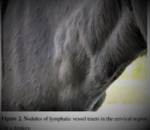Canine parvovirus is a disease that affects puppies and young dogs. Any young dog who exhibits vomiting or diarrhea should be suspected of having canine parvovirus. Detection of the early signs of parvo in puppies can be life-saving. In young dogs, canine parvovirus infection is extremely contagious and causes gastrointestinal illness. As a pet owner, keep yourself aware of prevalent diseases and their signs. It can save the life of your pet.
Parvovirus is a single-stranded, non-enveloped, DNA virus. It is resistant to all commonly available detergents and disinfectants. It can also withstand high temperatures and pH fluctuations.
Two types of canine parvovirus exist:
- Canine parvovirus type-1 (CPV-1)
- Canine parvovirus type-2 (CPV-2)
CPV-1 has always been present in the canine population and is avirulent. While CPV-2 is considered a modified feline panleukopenia virus. Clinical disease is largely attributed to CPV-2. Intact male dogs are more likely to develop CPV enteritis than intact female dogs.
Parvovirus in dogs multiplies in the rapidly dividing cells or cells undergoing mitosis. The virus has got an affinity for the lymphocytes and thus has some immunosuppressive effects. There is leucopenia in the initial stage of canine parvovirus infection, but this will not persist once the clinical symptoms appear.
How do dogs get parvo?
The virus is transmitted directly by the infected animal or its excretions. The virus can also spread through contaminated environments, equipment, and water, as well as the bowels. Parvovirus is primarily excreted in feces, and it enters healthy animals through oral and nasal contact.
Clinical signs of parvo in puppies
Two forms on the basis of clinical manifestation are observed.
1. Parvo virus enteritis
- Fever (the initial stage of the disease)
- Inappetance
- Refused to eat & apathetic in nature
- Hemorrhagic gastroenteritis
- Vomiting (frothy, yellow-colored)
- Diarrhea (fetid, small-bowel & hemorrhagic) (Diarrhea is non-hemorrhagic in 25% of dogs).
- Polydipsia
- Restlessness
- Dehydration due to diarrhea & vomiting
- Severely affected animals exhibit prolonged capillary refill time, poor pulse quality, tachycardia & hypothermia.
- Death occurs due to dehydration leading to peripheral circulatory failure.
2. Parvovirus myocarditis
- Pups under the age of 10 weeks are usually suffered from this form.
- Heart muscles are damaged
- Circulatory failure
- Death occurs due to cardiogenic shock

Canine Parvovirus Treatment
No specific treatment against canine parvovirus infection is available. Symptomatic treatment is performed following the early signs of parvo in puppies. Intensive care is required to treat this infection. Be prepared for a 5-7 days hospital stay and a substantial expense.
Death due to parvovirus occurs as a result of dehydration, electrolyte imbalance, metabolic abnormalities, heart failure due to myocarditis, and secondary bacterial invasions.
- Fluid Therapy
Fluid and electrolytes are to be given to restore the fluid and electrolyte losses. Potassium (potassium chloride 20–40 mEq/L) is usually added to the fluids and dextrose (2.5%–5%) is preferably added as stress causes hypoglycemia in puppies.
- Antibiotic Therapy (5-7 days)
Antibiotic therapy is essential to save the animal from bacterial invasion of the circulatory system (Sepsis). As the GI tract is damaged, so antibiotics should be given through IV/IM route. Antibiotics that are in use include
- Cefazolin (22mg/kg, IV, three times daily)
- 2nd or 3rd generation cephalosporins (cefoxitin, ceftazidime, Cefovecin & others)
- Ampicillin
- Gentamycin (9-12 mg/kg/day, IV)
- Chloramphenicol
- Norfloxacin & nalidixic acids have been proven to be effective against canine hemorrhagic gastroenteritis (Basak et al., 1993).
NOTE: Aminoglycoside antibiotics must not be administered until dehydration has been corrected and fluid therapy is established.
- For persistent vomiting drugs like metoclopramide can be used (@ 0.5 mg/kg) at 8 hours intervals. Other antiemetics that can be used include maropitant (1mg /kg/day IV) and ondansetron (0.5mg/kg, IV, three times daily).
- Anti-diarrheal drugs are generally not recommended, because retention of intestinal contents can lead to systemic complications and bacterial growth & movement.
- Colloid therapy should be considered when GI protein loss is severe.
- Withhold water & food until the cessation of vomiting
- After 12-24 hours of vomiting subsided, offer an easily digestible, low-fat, liquid diet to the animal.
- There is no evidence to support the use of serum from dogs recovered from CPV enteritis (convalescent or hyperimmune serum) as a means of passive immunization.
Parvo Puppies Prevention
Follow the given guidelines for parvo puppies prevention.
- Strict hygienic measures should be adopted in a kennel where an outbreak has set in. Practice good hygiene: Wash your hands thoroughly after handling your dog, her food, and toys, and before and after you come in contact with another dog.
- Follow the basic guidelines of dog care and management. Keep your dog away from areas where other dogs may have been: Parvovirus is highly contagious and can be spread from one dog to another through contact with an infected dog’s feces or vomit. Keep your dog away from areas where other dogs may have been and avoid taking your dog to dog parks.
- Infected & diseased dogs should be separated from healthy ones. Keep your dog away from other dogs: Do not allow your dog to socialize with other dogs, especially if they have not been up to date with their vaccinations.
- All the excreta (feces) should be properly disposed of and the premises should be disinfected. Always pick up and dispose of your dog’s feces in a sealed bag to reduce the risk of spreading the virus to other dogs.
- Vaccination with the modified live vaccine is recommended as a preventive measure. Vaccinate your dog against parvovirus: Vaccines are the most effective way to protect your dog from parvovirus. Make sure your dog is up to date on all its vaccinations.
- Monitor your dog’s health: If your dog shows any signs of illness, make sure to take him to the vet immediately. Early diagnosis and treatment are key to preventing the spread of parvo in puppies.
FAQ
Dogs can get parvo from the vomit and feces of an infected buddy dog. Parvo spreads through the dissemination of the virus that causes the infection. The excretions of an infected dog contain the virus. These excretions contaminate the environment, dogs’ food, water bowls, and dog body surface. Healthy dogs can get parvo by contacting the contaminated environment.
No, older dogs cannot get parvo. Parvo is a common fatal disease in puppies that are less than six months of age and have not been vaccinated. Adult dogs that have been vaccinated or even not vaccinated are usually immune to parvo, but there are some cases in which an older dog can contract the virus. You can face parvo in your older dog, but that is very rare.
Parvo is treated symptomatically. No specific treatment is available for parvo. Symptomatic treatment includes the use of different antibiotics and electrolyte therapy. Intensive care is required to treat parvo. Consult with a veterinarian for food and other care elements of your pet.


